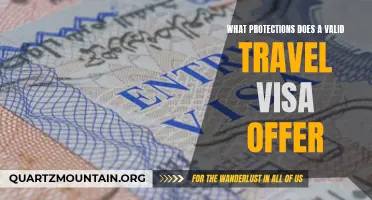
Traveling to another country can be an exciting and transformative experience, but it can also come with its fair share of bureaucratic red tape. One of the most important documents you need when traveling abroad is either an Electronic Travel Authority (ETA) or a visa. While these two terms may sound similar, they actually have significant differences that travelers should be aware of. Understanding the distinctions between an ETA and a visa is crucial for ensuring a smooth and hassle-free journey. In this article, we will delve into the intricacies of these travel documents and shed light on their respective requirements, benefits, and limitations. So, whether you're planning a short vacation or a long-term relocation, let's unravel the complexities of an ETA and a visa to make your travel aspirations a reality.
What You'll Learn

Introduction to Electronic Travel Authority (ETA) and Visa
When it comes to international travel, one of the most important things to consider is the necessary travel documents. In many cases, this includes obtaining either an Electronic Travel Authority (ETA) or a visa. While these two terms are often used interchangeably, they are actually different types of travel documents. In this article, we will explore what an ETA and a visa are and how they differ from each other.
An Electronic Travel Authority (ETA) is a type of entry permission that certain passport holders can obtain before visiting certain countries. It is an electronically stored authorization that allows travelers to enter and stay in a country for a limited period of time. ETAs are typically used for short-term stays, such as tourism or business visits, and are often obtained online.
The ETA is electronically linked to the traveler's passport, so there is no need for a physical document or stamp. Once approved, the ETA is automatically recorded and accessible to immigration officials at the port of entry. This makes the process of entering a country faster and more convenient, as there is no need to go through the traditional visa application process.
A visa, on the other hand, is a document that is affixed to the traveler's passport and serves as permission to enter a foreign country. It is a physical document or sticker that is usually obtained from an embassy or consulate of the destination country before traveling. Unlike an ETA, a visa may require a more extensive application process, including submitting supporting documents, attending an interview, and paying a fee.
Visas can be issued for various purposes, such as tourism, business, study, or work. The type of visa required depends on the purpose and duration of the visit. Some countries have visa-free agreements with certain countries, allowing travelers to enter without a visa for a limited period of time. However, for most international travel, a visa is still the most common form of entry permission.
Differences between ETA and Visa
While both an ETA and a visa serve as entry permissions for international travel, there are several key differences between the two:
- Application Process: Obtaining an ETA is usually a simpler and quicker process compared to obtaining a visa. ETAs can often be obtained online by completing an application and paying a fee. Visas, on the other hand, may require more extensive paperwork, an interview, and a visit to an embassy or consulate.
- Duration of Stay: ETAs are generally issued for shorter stays, typically ranging from a few days to a few months. Visas, on the other hand, can be issued for longer durations, such as several months or even years, depending on the type of visa and the purpose of the visit.
- Destination Countries: ETAs are limited to specific countries that offer this type of entry permission. Common countries that offer ETAs include Australia, Canada, and the United States. Visas, on the other hand, are used by most countries worldwide and can be obtained for a wide range of destinations.
In summary, while an Electronic Travel Authority (ETA) and a visa both serve as entry permissions for international travel, they are different in terms of application process, duration of stay, and destination countries. ETAs are generally obtained online and are ideal for short-term stays, whereas visas require a more comprehensive application process and can be issued for various purposes and durations. Depending on your travel needs and the requirements of your destination country, you may need to obtain either an ETA or a visa before your trip. It is important to research and understand the specific entry requirements of your destination country to ensure a smooth and hassle-free travel experience.
Understanding the Visa Requirements for Traveling to Norway
You may want to see also

Differences Between Electronic Travel Authority (ETA) and Visa
Planning to travel abroad? One of the first things you need to sort out is your travel documentation. It's important to know the difference between an Electronic Travel Authority (ETA) and a visa to ensure a hassle-free journey. While they both grant you entry into another country, there are some important distinctions between the two. Let's take a closer look at the differences between an ETA and a visa.
Purpose of Travel:
An ETA is typically used for short-term visits such as tourism, business trips, or visiting friends and family. It allows you to stay in a country for a specific period, usually up to 90 days. On the other hand, a visa can have various purposes, including but not limited to work, study, or permanent residence. Depending on the type of visa, you may be able to stay in a country for a longer duration or even permanently.
Application Process:
Obtaining an ETA is generally a quick and straightforward process. It can usually be done online through the official government website of the country you plan to visit. You'll need to provide basic personal information, your passport details, and answer a few eligibility questions. Payment of the ETA fee is also required. Visa applications, on the other hand, can be more complex and time-consuming. They often require additional supporting documentation, such as financial statements, medical reports, and letters of invitation. Visa applications usually involve an appointment at the embassy or consulate of the destination country.
Cost:
The ETA fee is typically lower compared to visa application fees. ETA fees can vary depending on the country you are visiting, but they are generally affordable. Visa application fees, however, can be significantly higher, especially for long-term visas or visas for specific purposes like work or study. In addition to the application fee, there may be additional costs associated with visa processing, such as mailing fees or fees for medical examinations.
Processing Time:
ETAs are usually processed quickly, often within minutes or a few days. In some cases, you may receive instant approval. This makes ETA a convenient option if you need to travel on short notice. Visa processing times can vary greatly depending on the country and type of visa. It can take several weeks or even months to obtain a visa, especially if there are additional processing requirements or a high volume of applications.
Validity and Entry Limits:
An ETA is typically valid for multiple entries within a specified period. For example, you may be able to enter and exit the country multiple times within 12 months. Some ETAs may have restrictions on the maximum length of each stay, but you can usually leave and re-enter to reset the duration. Visas, on the other hand, can have different validity periods and entry limits depending on the type of visa and the country's immigration policies. Some visas may allow for multiple entries, while others may be single-entry only. It's important to read the visa requirements carefully to understand the limitations.
In conclusion, an ETA and a visa are both travel documents that allow you to enter a foreign country, but they have different purposes, application processes, costs, processing times, and entry limits. Depending on the nature of your travel and the requirements of the destination country, you may need to obtain either an ETA or a visa. Be sure to check the specific requirements and regulations for your intended destination to ensure a smooth and successful journey.
The Ultimate Guide to Creating a Travel Itinerary for Canada Tourist Visa
You may want to see also

Application Process for Electronic Travel Authority (ETA) and Visa
An electronic travel authority (ETA) and a visa are two different documents that allow individuals to travel to a foreign country. While they serve a similar purpose, understanding the differences between the two can help streamline the application process and ensure a smooth travel experience. In this article, we will discuss the application process for an electronic travel authority and a visa.
The Application Process for an Electronic Travel Authority (ETA):
- Determine if you are eligible: Before starting the application process, make sure you are eligible for an ETA. An ETA is typically available to citizens of certain countries who are traveling for tourism or business purposes and planning to stay for a short duration.
- Gather the required documents: To apply for an ETA, you will need to gather the necessary documents. These typically include a valid passport, a credit card for payment, and any additional documents specific to your country of origin.
- Complete the online application: The application for an ETA is usually completed online. Visit the official government website of the country you are traveling to and look for the ETA application section. Fill out the application form accurately and provide all the required information.
- Pay the application fee: After completing the application form, you will need to pay the ETA application fee. This fee is non-refundable, regardless of the outcome of your application.
- Submit the application: Once you have paid the fee, submit your ETA application. It is important to double-check all the information before submitting to ensure accuracy.
- Wait for processing: After submitting your application, you will need to wait for it to be processed. The processing time can vary depending on the country and other factors. It is advisable to apply well in advance of your planned travel date to allow for any delays in processing.
- Receive your ETA: If your application is approved, you will receive your ETA electronically. It is a good practice to print a copy of your ETA and keep it with your travel documents.
The Application Process for a Visa:
- Determine the correct visa type: Before starting the visa application process, determine the correct visa type for your travel purposes. Different visa types are available for various reasons such as tourism, work, study, or residency.
- Research the visa requirements: Each country has its own visa requirements, so it is essential to research the specific requirements for your destination. This may include documents such as a passport with a validity of at least six months, proof of accommodation, travel itinerary, financial statements, and possibly a letter of invitation.
- Complete the application form: Once you have gathered all the required documents, complete the visa application form. This can be done online or through a paper application, depending on the country's application process.
- Pay the visa application fee: Similar to an ETA, a visa application fee is required. The fee varies depending on the type of visa and the country you are applying to.
- Submit the application: After completing the application form and paying the fee, submit your visa application. Double-check all the information before submission to avoid any mistakes or delays.
- Biometric appointment (if applicable): Some visa applications require applicants to schedule a biometric appointment to provide fingerprints and have their photo taken. This step may be necessary for security and identification purposes.
- Attend an interview (if applicable): Depending on the country and visa type, an interview may be required as part of the application process. If this is the case, schedule an interview appointment and prepare for the interview by bringing all necessary documents and answering questions truthfully.
- Wait for processing: Once the visa application is submitted, you will need to wait for it to be processed. The processing time can vary greatly depending on the country and the complexity of your application.
- Receive your visa: If your visa application is approved, you will receive your visa stamped in your passport or as a separate document. Make sure to keep your visa with your travel documents and check that all the information is correct.
It is important to note that while an ETA allows for short-term travel, a visa may allow for longer-term stays or different types of activities. It is essential to choose the correct document based on the purpose and duration of your travel. It is recommended to start the application process well in advance of your planned travel date to allow for any delays or additional requirements that may arise.
Is a Travel Visa Required for Japan?
You may want to see also

Advantages and Disadvantages of Electronic Travel Authority (ETA) and Visa
An electronic travel authority (ETA) is not the same as a visa, but it serves a similar purpose. Both ETA and visa allow foreign nationals to travel to a foreign country, but there are some key differences between the two. In this article, we will discuss the advantages and disadvantages of ETA and visa to help you understand which option is best for your travel needs.
Advantages of Electronic Travel Authority (ETA):
- Convenience: One of the biggest advantages of an ETA is its convenience. The application process can be completed online without the need for a physical visit to the embassy or consulate. This saves you time and effort, especially if you live in a remote location or have a busy schedule.
- Quick Processing: In most cases, an ETA is processed and approved within a short period of time, often within hours or a few days. This makes it an ideal choice for travelers who need to make last-minute travel arrangements or are on a tight timeline.
- Multiple Entry: Many countries that offer ETAs allow multiple entries within a specified period. This means that you can travel in and out of the country multiple times without having to apply for a new authorization each time. This is particularly beneficial for frequent travelers or those who plan to visit neighboring countries during their trip.
- Cost-effective: Generally, an ETA is more affordable than a visa. The cost of an ETA is often lower, and there may be additional advantages such as waiving visa application fees for ETA holders. This makes it a budget-friendly option for travelers.
Disadvantages of Electronic Travel Authority (ETA):
- Limited Duration: ETAs typically have a shorter validity period compared to visas. While the duration varies depending on the country, it is usually limited to a few months. If you plan to stay in the foreign country for an extended period, you may need to apply for a visa instead.
- Restrictions on Activities: ETAs may have restrictions on certain activities, such as working or studying in the foreign country. If you plan to engage in activities beyond tourism, you may need to obtain a visa that allows the specific purpose of your visit.
- Exclusive to Certain Countries: ETAs are only offered by specific countries, so it may not be an option for every destination. If you are planning to travel to a country that does not offer an ETA, you will need to apply for a visa instead.
Advantages of Visa:
- Longer Duration: Visas typically have a longer validity period compared to ETAs. This allows you to stay in the foreign country for an extended period without the need for frequent renewals or extensions.
- Flexibility: Visas often allow you to engage in a wide range of activities, such as employment, education, or business. This gives you more flexibility in terms of your stay and the purpose of your visit.
- Global Acceptance: Visas are widely accepted by most countries around the world. This means that if you have a visa, you can travel to multiple destinations without the need for additional authorizations.
Disadvantages of Visa:
- Complex Application Process: Obtaining a visa can be a complex and time-consuming process. It often involves gathering various documents, such as passport copies, financial statements, and invitation letters, and may require an in-person visit to the embassy or consulate.
- Higher Cost: Visas are generally more expensive than ETAs. In addition to the visa application fees, you may need to pay for other expenses such as travel insurance, medical examinations, and translation services.
- Longer Processing Times: Visa applications can take significantly longer to process compared to ETAs. This can be a disadvantage if you need to travel urgently or have time-sensitive plans.
In conclusion, both ETAs and visas have their advantages and disadvantages. The choice between the two depends on various factors such as the purpose and duration of your stay, the activities you plan to engage in, and the country you are visiting. It is advisable to carefully consider your travel needs and requirements before making a decision.
Traveling to Canada with an Expired F1 Visa: What You Need to Know
You may want to see also
Frequently asked questions
No, an electronic travel authority (ETA) is not the same as a visa. While both allow entry into a foreign country, an ETA is a simpler and faster process that is usually only available for short-term visits. A visa, on the other hand, is a more comprehensive document that permits longer stays, work, study, or residency in a foreign country.
To obtain an electronic travel authority (ETA), you usually need to submit an online application through the official government website of the country you intend to visit. The application typically requires personal information, passport details, and travel plans. Once approved, the ETA will be electronically linked to your passport.
It depends on the country and the type of ETA. Some electronic travel authorities allow multiple entries within a specific time period, while others are single-entry only. Make sure to check the terms and conditions of the ETA you're applying for to determine if it allows multiple trips or not.
The validity of an electronic travel authority (ETA) can vary depending on the country issuing it. It can be valid for a few months up to several years. It's important to check the specific validity period of the ETA you have been granted to ensure that it covers your intended travel dates.







